THE SALVESEN ARCHIVE CONTAINS THE NORWEGIAN WHALING GAZETTE, FROM 1917 TO 1968 – A WEALTH OF RESEARCH ON WHALES AND WHALING FROM THE DECADES PRIOR TO THE INTERNATIONAL WHALING COMMISSION (IWC) MORATORIUM, 1986
 The Salvesen Archive is one of the larger collections in the care of the Centre for Research Collections (CRC). It is composed of manuscript and typescript material in the form of correspondence, diagrams, charts, accounting data, and photographs relating to some of the maritime and whaling activities of the long gone Christian Salvesen & Co. of Leith. It can be regarded as a ‘hybrid collection’ as well, containing printed pamphlets and journals, a small amount of books, and a few three-dimensional objects. Of particular interest to those keen to research the 20th century whaling industry is a reasonably long run of the periodical The Norwegian Whaling Gazette, or Norsk Hvalfangst-Tidende.
The Salvesen Archive is one of the larger collections in the care of the Centre for Research Collections (CRC). It is composed of manuscript and typescript material in the form of correspondence, diagrams, charts, accounting data, and photographs relating to some of the maritime and whaling activities of the long gone Christian Salvesen & Co. of Leith. It can be regarded as a ‘hybrid collection’ as well, containing printed pamphlets and journals, a small amount of books, and a few three-dimensional objects. Of particular interest to those keen to research the 20th century whaling industry is a reasonably long run of the periodical The Norwegian Whaling Gazette, or Norsk Hvalfangst-Tidende.

Bound copies of journal, ‘The Norwegian Whaling Gazette’ [Salvesen Archive]
Connections with the Norwegian Whaling Association became even closer on the appointment of Sigurd Risting (1870-1935) as editor in April 1922. Risting had been Secretary of the Norwegian Whaling Association. Formerly the headmaster of the local school, Risting had joined the editorial staff of the journal in June 1914.
On Risting’s death, Harald B. Paulsen (1898-1951) succeeded both as Secretary of the Whaling Association and as editor of the journal (Paulsen Peak in the Allardyce Range, South Georgia, was named after him). On his death, Einar Vangstein took over both jobs. Latterly, the journal had become a bimonthly title. In later years too, its articles appeared in both Norwegian and English.
By the late 1960s, all members of the International Association of Whaling Companies had ceased whaling and it was deemed no longer necessary for the continued publication of The Norwegian Whaling Gazette, and issue number 6, published November / December 1968, marked the end of its existence.
Articles in the journal were varied, scientific, and generally informative on many things cetacean, covering subjects such as: the determination of fat in whale meat extract; studies on the structure of baleen plates and their application to age determination; propellers for whaling ships made by KMW (Krauss-Maffei Wegmann, based in Munich); the marking of whales in New Zealand waters to measure resources; whales entangled in deep sea cables; the taxonomic position of the Pygmy Blue Whale; underwater sound from Sperm Whales; the cross-sectional anatomy of the dolphin; a new whaling station in Peru; and, the size of annual whale catches and annual seasonal oil production (indeed, throughout the life of the journal, the extent of whale catching and the size of the surviving whale was meticulously noted).
In addition, across many numbers of the journal during 1957 (Nos. 4-9), The Norwegian Whaling Gazette carried a historical narrative by the Norwegian Antarctic historian Hans Bogen, entitled Main events in the history of Antarctic exploration. Bogen also wrote a piece on Captain H. K. Salvesen for issue No. 9 of the journal in 1957.

Article appearing in No.11 of ‘The Norwegian Whaling Gazette’, 1934, p.182, offering an overview of the whale catch in the Southern Ocean, 1933-34. The South Georgia Co. Ltd. was a subsidiary of Christian Salvesen Co. Ltd. and at that time the firm operated the whale factory ships ‘Salvestria’ and ‘Sourabaya’ as well as the ‘fast stasjon’ or land-based shore station at Leith Harbour, South Georgia. The other firm noted as having a shore station was Compañía Argentina de Pesca SA (the Argentine Fishing Co.) operating at Grytviken, South Georgia

The above illustrations together show a list appearing in No.11 of ‘The Norwegian Whaling Gazette’, 1934, p.182, describing the companies operating in the Southern Ocean during whale catch season 1933-1934. The columns show, from the left: name of company; type of ‘kokeri’, whether factory ship or shore station; number of whales caught, whether Blue Whale, Fin Whale, Humpback Whale (Knølhval), Sperm Whale; the combined total of all of these whale species; number of barrels of Whale Oil and Sperm Oil; and, notes on whether the production was during pelagic operations, or at a shore station
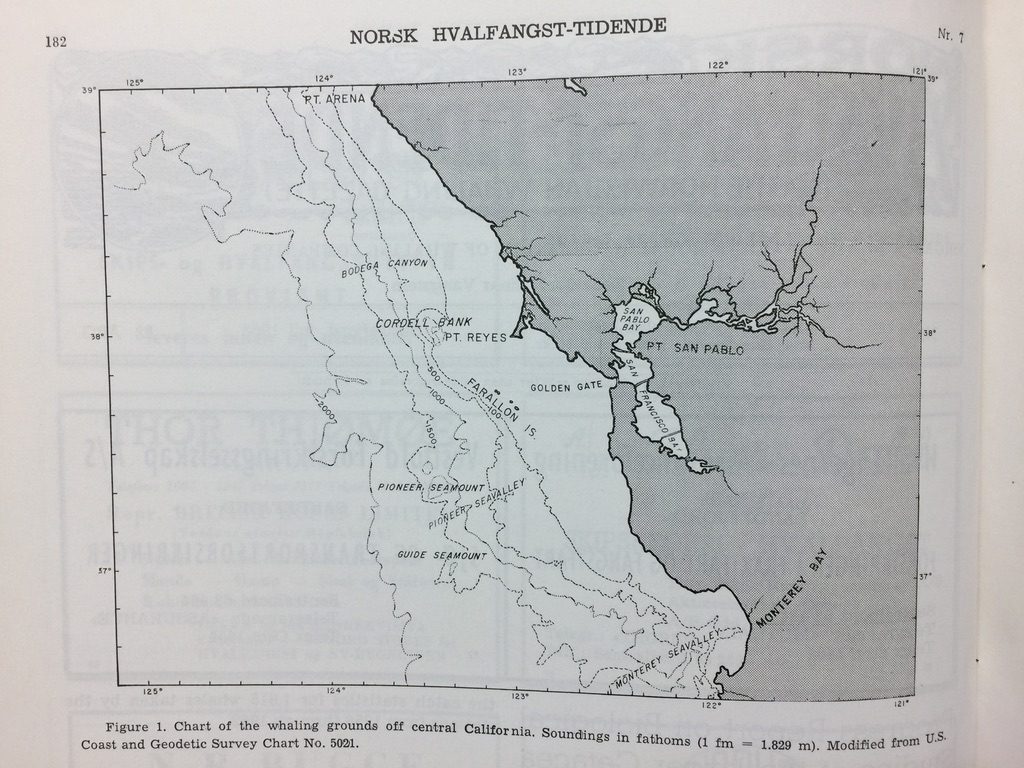
Chart of the whaling grounds off central California appearing in No.7 of The Norwegian Whaling Gazette, 1963, p.182. In the 21st century this maritime region can see 94% of migrating Pacific Grey Whales passing by, and Blue and Humpback Whales regularly feeding. Rather than facing slaughter, they are now the focus of a thriving tourist and whale watching industry. The main threats to nursing whales these days are ship propellers and Orca Whales
Advertising had provided the principal financial resource for the production of The Norwegian Whaling Gazette throughout its 57 years of life, with advertisements placed by firms involved in the supply to the whaling industry of goods and services as diverse as: industrial cookers and separators, ropes and line, whale cannons, explosives and gunpowder, marine oils and lubricants, and lowly milk powder.
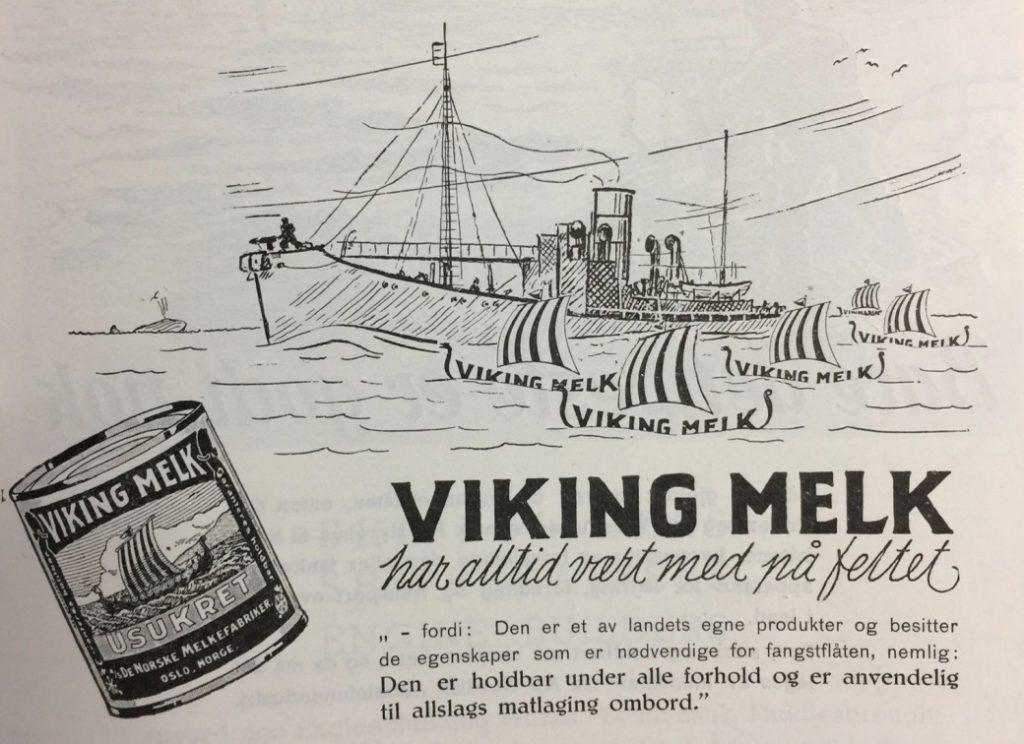
Ad’ for unsweetened ‘Viking Melk’ (dried milk powder) produced by De Norske Melkefabriker, Oslo, Norway. The firm claimed that ‘Viking Melk’ had always been ‘in the field’. Produced in Norway, the powder possessed all the characteristics necessary for use in the whaling grounds, namely: durability in all conditions and applicability to all types of cooking on board [Ad’ from an issue of ‘The Norwegian Whaling Gazette’, Salvesen Archive]
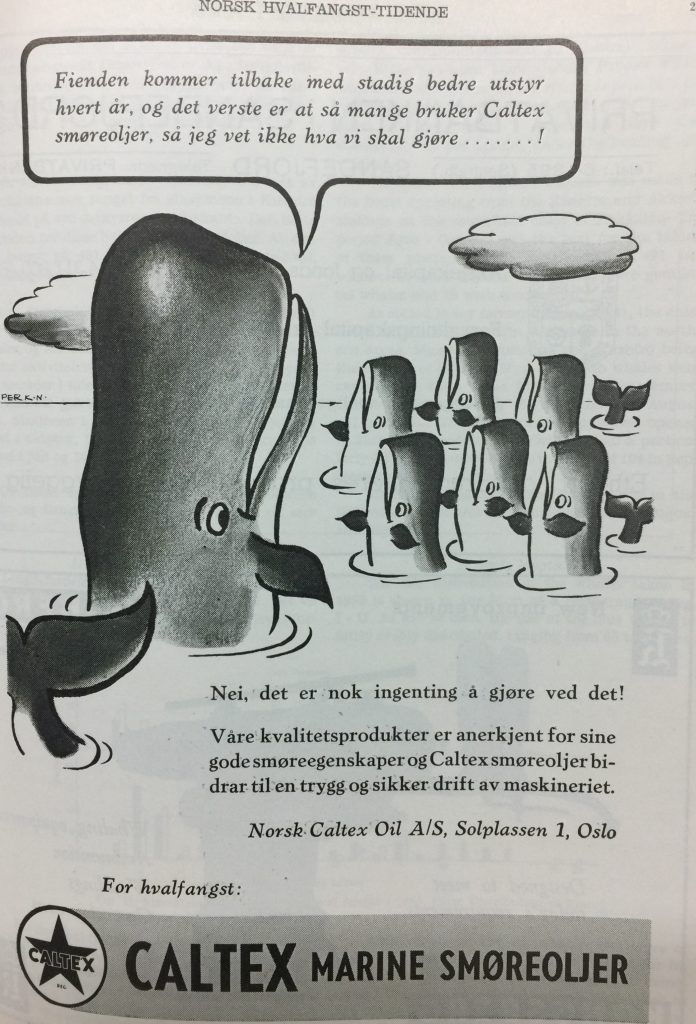
Ad’ for Caltex Marine Oils, placed by Norsk Caltex Oil A/S, Oslo, Norway. Caltex oils, the company claimed, were quality products recognized for their good lubricating properties, and Caltex lubricating oil contributed to a safe and secure operation of machinery. The ad’ was illustrated with a pod of whales. with the pod leader lamenting that the ‘enemy keeps coming with better equipment every year, the worst of it being that so many of them are using Caltex lubricating oil that I don’t know what we are going to do!’ [Ad’ from an issue of ‘The Norwegian Whaling Gazette’, Salvesen Archive]
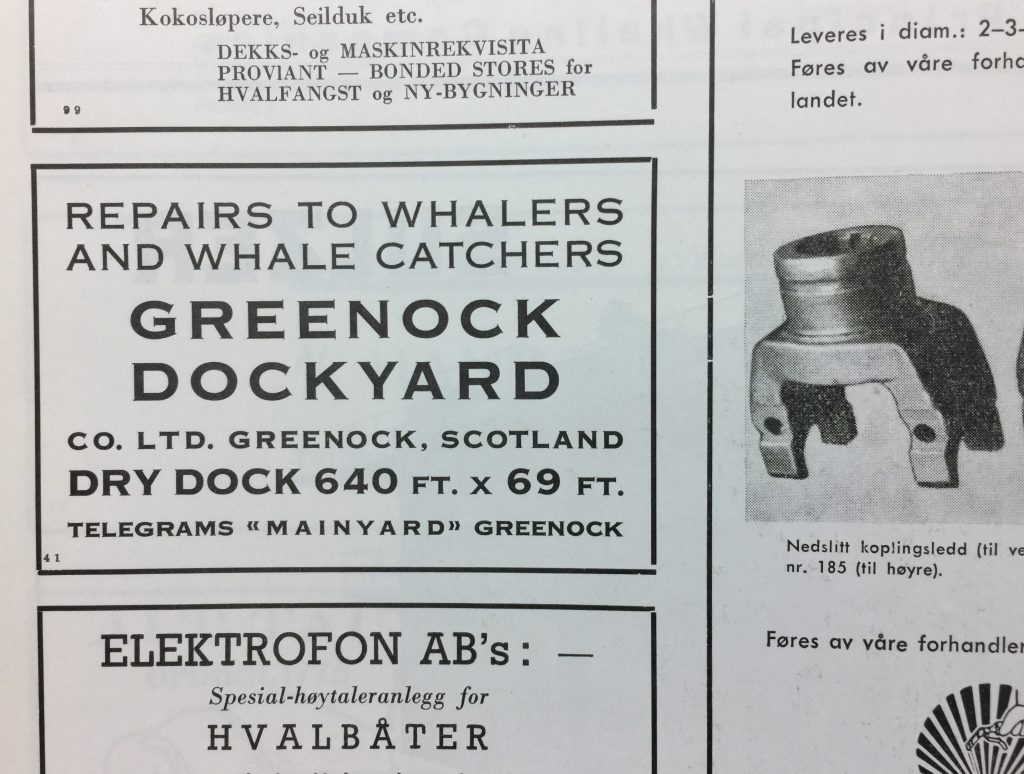
Ad’ placed by the Greenock Dockyard Company, Greenock, Scotland, a yard which built many types of vessel and performed repairs to them too. It was incorporated as Greenock Dockyard Co. Ltd. in 1920, and was earlier known as the Greenock & Grangemouth Dockyard Co., and before that had been owned by Russell & Co. of Greenock, and prior to that J. E. Scott of Greenock [Ad’ from an issue of ‘The Norwegian Whaling Gazette’, Salvesen Archive]
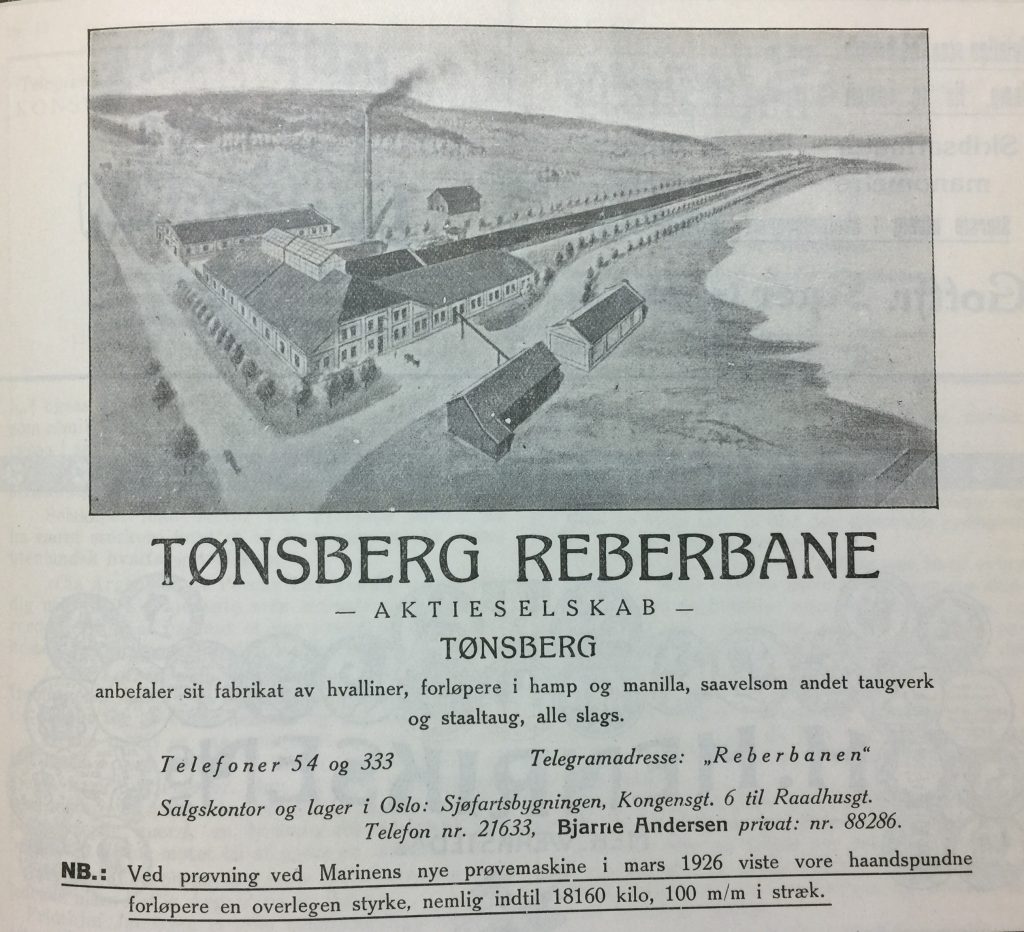
Ad’ for the former Tønsberg Reberbane AS, in Tnsberg, Vestfold, Norway. Tonsberg ropeworks….:
Graeme D. Eddie, Honorary Fellow, Centre for Research Collections, Edinburgh University Library… engaging with the Salvesen Archive of maritime trading and whaling
References:
Vangstein, Einar. ‘Editorial – The Norwegian Whaling Gazette’, Norsk Hvalfangst-Tidende, Vol.57. No.6, Nov/Dec.1968, p.117
If you have enjoyed reading this post, check out previous ones about the Salvesen Archive, or using Salvesen Archive content, which have been posted by units across CRC since 2014:
A narrative on the whaling industry: as told through a whale catch log-book and other items in the Salvesen Archive October 2019
Salvesen Archive – 50 years at Edinburgh University Library – 1969-2019 May 2019
Cinema at the whaling stations, South Georgia August 2016
Exploring the explorer – Traces of Ernest Shackleton in our collections May 2016
Maritime difficulties during the First World War – Christian Salvesen & Co. October 2015
Talk on the Salvesen Archive to members of the South Georgia Association November 2015
‘Empire Kingsley’ – 70th anniversary of sinking on 23 March 1945 March 2015
Pipe bombs, hurt sternframes, peas, penguins, stoways and cookery books: the Salvesen Archive July 2014
Whale hunting: New documentary for broadcast on BBC Four June 2014
Penguins and social life May 2014